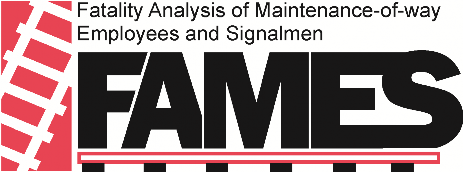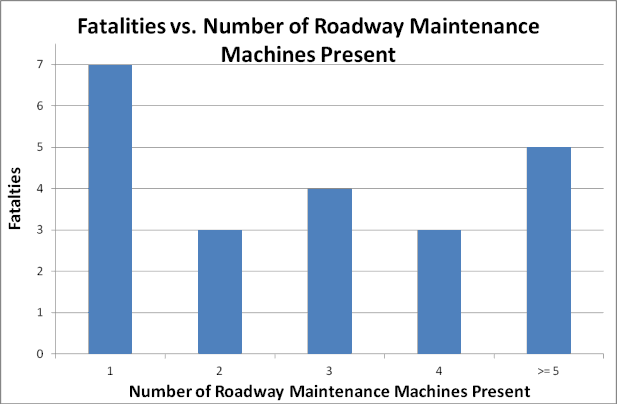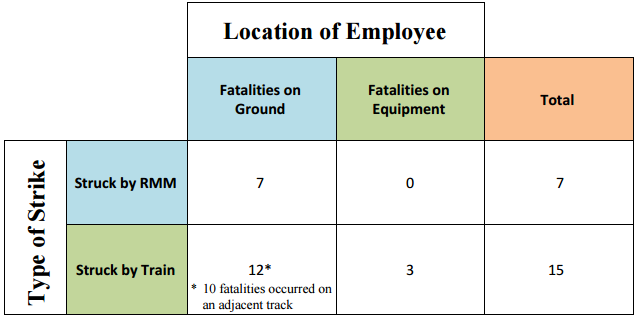Fatal Striking Accidents With Roadway Maintenance Machines Present Published: Oct 30 2015 12:24PM

Dedication: The FAMES Committee dedicates its efforts to all roadway workers who have lost their lives in the performance of duty and to the families, loved ones, and coworkers they have left behind. Mission Statement: The Mission of the Fatality Analysis of Maintenance-of-way Employees and Signalmen (FAMES) Committee is to analyze all fatalities and selected related incidents in order to make recommendations to reduce the risk of future occurrences and eliminate fatalities to roadway workers. Following the implementation of the Roadway Worker Protection (RWP) Rule in 1997, there have been a total of 42 fatal RWP accidents, in which 44 roadway workers have perished, as of January 1, 2012. The FAMES Committee was able to obtain data to analyze 39 fatal RWP accidents, which accounted for 41 of the 44 fatalities. The FAMES Committee analysis is based on the available data. For purposes of this report, “RMMs Present” means one or more Roadway Maintenance Machines (RMMs) were working within the fatally injured employee’s work group at the time of the accident.
At least one RMM was present in 22 of the 41 roadway worker fatalities reviewed. The chart below indicates the number of fatalities where RMMs were present and how many RMMs were present in each of the 22 fatalities.

The following table shows the location of fatally injured employees and whether the fatally injured employees were struck by a RMM or train.
Location of Employee and Type of Striking Equipment 
Roadway workers can become engrossed in their tasks when assigned to work with or near RMMs. A roadway worker focused on a machine-related task or a specific track maintenance activity while in the presence of one or more RMMs can experience a diminished ability to detect an approaching train or RMM movement.
Tampers and/or ballast regulators were present in 8 of the 22 employee fatalities. All 8 fatalities involved employees on the ground:
- 6 were struck and killed by a train passing on an adjacent track;
- 2 were struck and killed by a ballast regulator on the occupied track.
The available data indicates that noise, task complexity, sight lines, and the presence of an adjacent track all warrant heightened on-track safety awareness, especially when working around surfacing equipment.
Findings:
- Even a single RMM adds a level of complexity to the work environment and can cause distraction.
- Surfacing equipment was present in more fatal accidents than any other type of RMM.
- RMMs may obscure sight lines and affect a worker’s ability to visually detect approaching trains and equipment.
- Noise generated by RMMs may reduce the ability to hear approaching trains and equipment.
- RMM stopping distance is increased when rails are slick (e.g., wet, icy, oily/greasy).
The FAMES Committee makes the following recommendations:
- During the on-track safety briefing, identify if RMMs will be present and take actions to manage any additional risks associated with their presence.
- Assess any risk associated with movements on adjacent tracks.
- Before fouling the adjacent track, RMMs must have proper protection on the adjacent track.
- An adjacent track must never be used as a platform from which to observe work or walk around work/equipment, unless an appropriate form of on-track safety is in effect on the adjacent track.
- Maintain a safe distance between RMMs when traveling or working.
- Mount and dismount RMMs on the field side, not on a live track side, when possible.
- Identify and discuss environmental conditions (e.g., wet, icy, oily/greasy rails) affecting the stopping distance of RMMs.
- RMM operators must clearly communicate signals for slowing, stopping, and changing direction.
- Establish clear communication and maintain proper clearance between RMM operators and workers on the ground. Communicating change in direction is imperative.
The FAMES Committee consists of safety representatives from a cross section of rail labor, railroad management, and federal regulators. FAMES is a continuous improvement process that relies on the candid sharing of available data and the views of its participants. To enable the process, FAMES explicitly refrains from making any findings regarding whether any past or present practice or protocol satisfies any legal duty or standard of care.
The views, opinions, and recommendations contained in this report are those of the FAMES Committee and do not necessarily represent the views, opinions, or recommendations of any specific railroad, labor organization, or governmental agency.